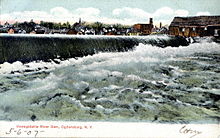- Oswegatchie River
-
The Oswegatchie River is a 137-mile-long (220 km)[1] river in northern New York that flows north from the Adirondack Mountains to the Saint Lawrence River at the city of Ogdensburg. The river mouth was the site of a Jesuit mission, Fort de La Présentation, founded in 1749. Also a fur trading post, the village had 3,000 Onondaga by the 1750s, most of whom converted to Catholicism. They came to be known as the Oswegatchie, considered somewhat separate from the Six Nations of the Iroquois.[2] Oswegatchie may be Iroquois for "going or coming around a hill". William Bright says the name may come from the Onondaga word /oshewɛ'gaaji'/, meaning "black lumber", containing -shewɛ'gar-, "lumber", and -ji-, "be black".[3] The Oswegatchie were one of the Seven Nations of Canada.
The river comprises three branches named East, West and Middle. All of the branches begin in the Five Ponds Wilderness, with the East Branch Oswegatchie beginning at Partlow Lake, which is privately owned by one of William Seward Webb's descendants. It is planned to be donated to New York via an easement agreement, late in the next decade. One of its branches, the Robinson River, begins at Crooked Lake. The Middle Branch headwaters are Willy's and Walker Lakes with one of its headwaters, an unnamed pond, separated from Crooked Lake by approximately fifty feet of land. The West Branch Oswegatchie has its headwaters at Buck and Hog Ponds, which are separated from a smaller branch of the Middle Branch Oswegatchie by a short distance of land.
The Middle Branch Oswegatchie mostly consists of shallow and fast moving waters with only two or three slow-moving sections favorable for canoeists. These include Alder Bed Flow and another still-water section known locally as Moynehan Flow. The latter begins in the area where Lower South Pond Outlet runs into the river. Occasionally, experienced kayakers take advantage of high water conditions to ply its waters- generally, from the Bear Pond Road, which is a few miles upstream of Alder Bed Flow & downstream to another seasonal access road located near Mullins Flow. However, because they are seasonal roads and the area is so remote- this is a seldom seen scenario. Brook trout exist as the primary sport-fish for its entire length. Chubs & bullheads also exist in its waters.
The West Branch Oswegatchie is slower moving than the Middle Branch, but the still waters such as: Long Pond, Mud Pond & Long Level are separated by hard to traverse rapids and/or waterfalls. With its far-upstream sections consisting of small & narrow feeder streams, which are generally, not canoe-able due to fallen logs & overhanging alders. During Depression times, deeded fishing rights were procured by NYS for the public on most of the river and the Civilian Conservation Corps created a public trail from where the outlet of Mud Pond crosses the Long Pond Road, downstream to the Jerden Falls Road. Today, no sign of the trail exists, but the deeded fishing rights for the public remain, despite new landowners in some locations. Brook trout are the main sport-fish and shiners, sunfish, suckers, chubs, minnows, bullheads and other fish exist in its waters.
The Middle Branch Oswegatchie unites with the West Branch Oswegatchie near the village of Harrisville in Lewis County. The river continues downstream as the West Branch Oswegatchie, until it unites with the East Branch Oswegatchie at a point a short distance west of the village of Talcville in St. Lawrence County. From that point, it is simply, known as "The Oswegatchie", as it flows northerly to its terminus with the St. Lawrence River near Ogdensburg.
The East Branch of the Oswegatchie begins in Hamilton County, New York. The lower part of the main stem of the river, between Gouverneur and Ogdensburg, is slow-moving with some rapids that can be handled by experienced canoeists.
Important fish species include smallmouth bass, northern pike, musky, channel catfish, walleyes, red-finned mullet, and common carp.
The middle section of the Oswegatchie and the East Branch Oswegatchie, between Gouverneur (village) and Cranberry Lake, is partially navigable by experienced canoeists. A two-mile section from southern Cranberry Lake to Inlet is unnavigable. From Inlet, the upper Oswegatchie is one of the wildest canoeable rivers in the Adirondacks.[4] The area is rich in history from logging days to the present. The upper river provides access to some of the remotest parts of Adirondack Park. Near the southern edge of St. Lawrence County it goes over High Falls. There is a 3.5-mile (5.6 km) portage at the old historic "Beaverdam" that allows canoeists to travel to Lows Lake and the Bog River. These are all located in the Five Ponds Wilderness Area.
References
- ^ "The National Map". U.S. Geological Survey. http://viewer.nationalmap.gov/viewer/. Retrieved Feb. 11, 2011.
- ^ Simms, Jeptha Root, Trappers of New York, p. 249, Harrison, NY: Harbor Hill Books, 1850, 1871, reprinted 1980, ISBN 0916346382
- ^ Bright, William (2004). Native American placenames of the United States. University of Oklahoma Press. p. 359. ISBN 9780806135984. http://books.google.com/books?id=5XfxzCm1qa4C&pg=PA359. Retrieved 14 April 2011.
- ^ Jamieson, Paul F., and Donald Morris, Adirondack Canoe Waters: North Flow, third ed., Adirondack Mountain Club, Lake George, NY, 1988, rev. 1994, ISBN 9780935272437
See also
- List of New York rivers
- List of Wilderness Areas in the Adirondack Park
Categories:- Rivers of New York
- Adirondacks
Wikimedia Foundation. 2010.






